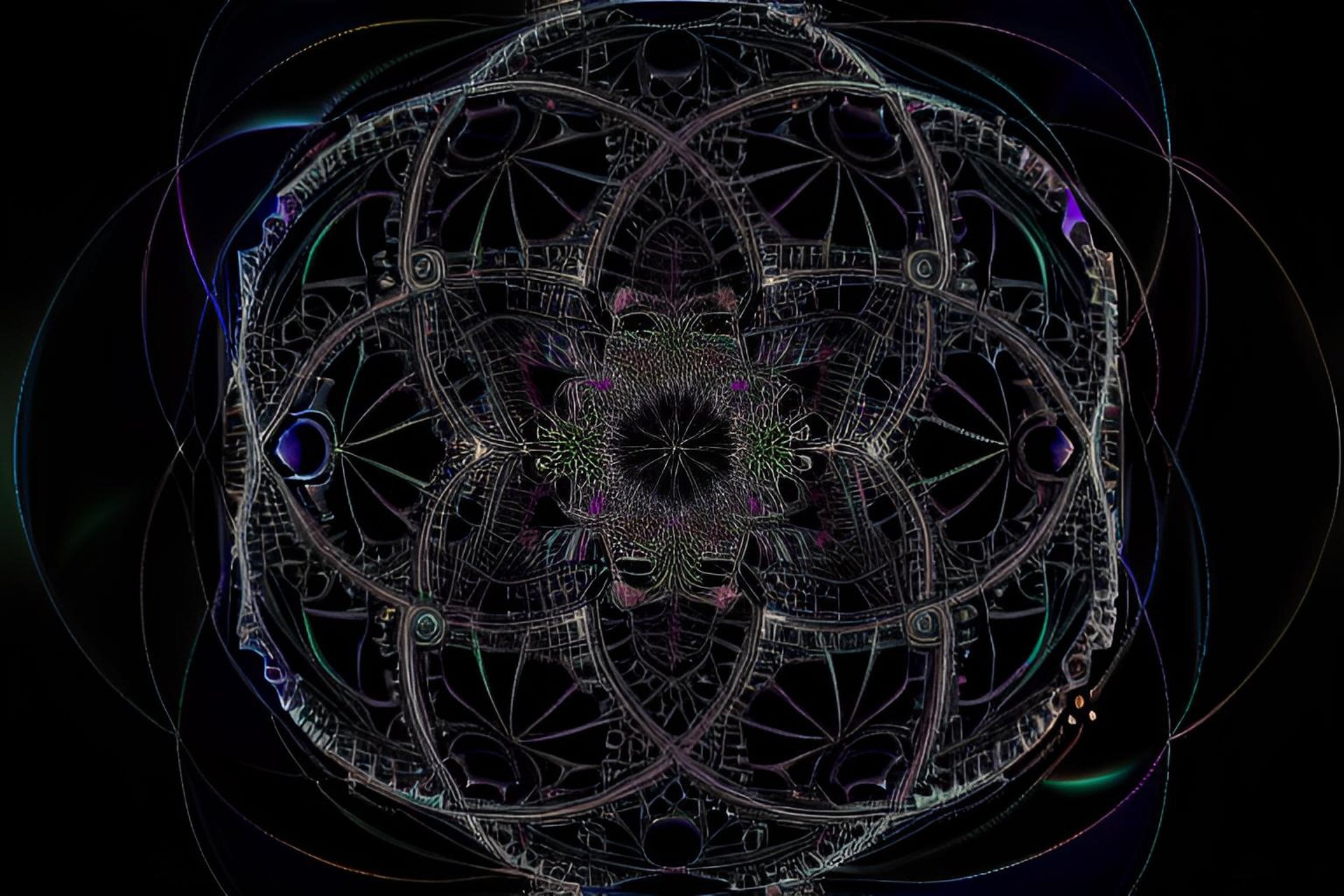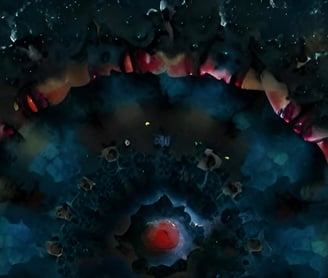
The Dance of Duality: Finding Harmony in Life's Opposites
Harmonizing Life through the Balance of Opposites and the Quest for Unity


Introduction to the Concept of Duality and Its Role in Life and Personal Growth
Life is a dance of duality. It is an intricate tapestry woven with threads of contrasting colours - joy and sorrow, success and failure, light and darkness. These dualities are not just stark contrasts, but represent different degrees of the same spectrum. From the ancient wisdom of Hermetic Philosophy to the contemporary insights of Chaos Theory, the theme of duality permeates our understanding of the universe and our place within it.
The Hermetic Principle of Polarity posits that everything in existence is dual, has poles, and contains its pair of opposites. In other words, apparent opposites are simply varying degrees of the same thing. To comprehend this concept, consider the example of temperature. Hot and cold may seem like distinct entities, but they are actually part of the same continuum - merely expressions of different levels of thermal energy. This principle underscores the fundamental unity underlying all apparent differences and oppositions, a unity that forms the very fabric of existence.
Chaos Theory, a branch of mathematics dealing with complex systems, provides a modern perspective that echoes this ancient wisdom. Its concept of chaotic attractors represents the balance and interaction of opposing forces within dynamic systems. Here, seemingly chaotic or random states eventually reveal an underlying order and balance, mirroring the Hermetic view of harmony emerging from duality.
These contrasting yet complementary forces shape our lives in profound ways. Embracing the dance of duality is essential for personal growth. Recognizing that joy and sorrow, for instance, are different facets of the human experience allows us to engage fully with life, appreciating its peaks and troughs alike. This acceptance opens the door to resilience, enabling us to navigate life's difficulties with grace and equanimity.
However, acknowledging duality is just one part of the equation. As we become comfortable with life's contrasts, we must also seek unity amidst them. The quest for unity helps us recognize the interconnectedness of all things, fostering a sense of wholeness. By balancing our understanding of duality with a pursuit of unity, we can find harmony in our lives, cultivate inner peace, and develop a deeper appreciation for the interconnected dance of existence.

Understanding the Complementary Nature of Opposites in Various Aspects of Life
In the dance of life, opposites often come together in a harmonious interplay that shapes our existence. To truly appreciate this, we must understand the complementary nature of opposites and how they manifest in our lives.
Consider the concept of Yin and Yang in Eastern philosophy. This principle suggests that all things exist as inseparable and contradictory opposites, each giving rise to the other as they interrelate. Day and night, hot and cold, growth and decay – each pair is an example of Yin and Yang. In this philosophy, balance isn't achieved by eradicating one end of the spectrum, but by acknowledging and harmonizing both.
Similarly, consider the example of human emotions. Happiness is often most deeply appreciated after we've experienced sorrow. The existence of sadness gives depth and context to our joy, making the experience of happiness more profound. Both emotions are essential, providing a balance that adds richness to our human experience.
In the world of physics, we see this in the law of conservation of energy, which states that energy can neither be created nor destroyed, only transferred or transformed from one form to another. This continual dance between potential and kinetic energy drives the movements and changes we see in our physical world, highlighting the importance of balance between opposing forces.
In the realm of personal growth and self-improvement, struggle and ease similarly play complementary roles. Challenges and hardships often foster strength, resilience, and personal growth, while periods of ease allow for recovery and appreciation of the progress made.
Understanding the complementary nature of these opposites encourages us to strive for balance in various aspects of our lives. Rather than seeking to eliminate one end of the spectrum, we can aim to appreciate and harmonize the opposing forces, enriching our overall life experience. The interplay between these opposites underscores the importance of balance – a state of equilibrium that allows for sustainable growth, stability, and harmony.


Join The Growing Community
Harmonizing Life: Embracing Opposites and Cultivating Unity


In our fast-paced, ever-changing world, finding balance between opposing forces can often seem like an elusive goal. However, understanding the complementary nature of these forces can guide us towards equilibrium and unity. Achieving balance doesn't mean eliminating one end of the spectrum, but rather, learning to harmonize the co-existing opposites to create a rhythm that resonates with our lives. In seeking unity, we strive to perceive the interconnectedness and oneness underlying apparent dualities.
The quest for balance and unity is a journey of exploration and self-discovery. It calls for mindfulness, self-awareness, and a willingness to embrace the ebbs and flows of life. It invites us to cultivate a perspective that transcends the surface-level differences and seeks the underlying connections that bind us all.
Practice Mindfulness:
Engage in daily mindfulness exercises, such as meditation or deep breathing, to foster awareness and presence.
Regularly check in with your thoughts, feelings, and physical sensations, acknowledging them without judgment.
Embrace Self-Reflection:
Regularly take time for introspection to understand your responses to various situations.
Evaluate your reactions and responses to identify any imbalances or biases.
Cultivate Acceptance:
Learn to accept the dualities of life, understanding that opposing forces often exist in harmony.
Embrace challenges and successes, highs and lows, with the same degree of acceptance and understanding.
Practice Gratitude:
Develop a daily habit of expressing gratitude, even for the challenging aspects of life.
Recognize that each experience, whether pleasant or difficult, contributes to your growth.
Foster Connection and Compassion:
Practice empathy and compassion, striving to understand others' perspectives and experiences.
Foster connections with diverse individuals to appreciate the various dualities in human experiences.
Engage in Healthy Physical Practices:
Regular physical exercise can help maintain balance between physical exertion and rest.
Adequate sleep, a balanced diet, and regular relaxation practices can contribute to overall physical and mental equilibrium.

Embracing the Dualities of Life: The Hermetic Principle of Polarity in Modern Times
In the ever-evolving panorama of life, we find ourselves continually oscillating between the poles of diverse dualities. These dualities, inherent in our existence, are not merely arbitrary contrasts, but rather, they embody the profound wisdom of the Hermetic Principle of Polarity. This ancient principle, rooted in the Hermetic philosophy, suggests that all manifested things possess two poles or opposites, and these opposites are simply varying degrees of the same thing. Embracing this principle can significantly enhance our understanding of life, fostering balance, harmony, and unity amidst apparent contradictions.
In the sections that follow, we delve into the exploration and application of the Principle of Polarity in our modern life. We begin by understanding and embracing life's dualities, then move on to the practice of non-duality meditation as a tool for transcending binary opposites. Finally, we examine the application of this principle in conflict resolution, demonstrating its potential to foster unity and cooperation in our relationships and communities.
Understanding and Embracing Life's Dualities:
The first step in exploring the Principle of Polarity is to understand and accept the existence of dualities in all aspects of life. This principle posits that all things have two poles or opposites, and these opposites are simply different expressions of the same thing. For example, heat and cold are simply varying degrees of the same thing – temperature. Similarly, joy and sorrow, love and hate, fear and courage, are all different degrees of the same spectrum of human emotions.
By acknowledging and embracing these dualities, we can develop a more nuanced and holistic understanding of life. This acceptance allows us to experience the full spectrum of human emotions and experiences without being overwhelmed by them. It also helps us to cultivate emotional resilience and equanimity, enabling us to navigate life's ups and downs with grace and wisdom.
Practicing Non-Duality Meditation:
Non-duality meditation serves as a powerful tool for exploring the Principle of Polarity. This form of meditation involves observing our thoughts, feelings, and sensations without judgment, and recognizing the interconnectedness and oneness underlying apparent dualities. It encourages us to transcend our habitual patterns of thinking and perceiving, and to experience the world and ourselves without the constraints of binary opposites.
Regular practice of non-duality meditation can lead to profound shifts in our perception of self and reality. It can help us to cultivate a state of consciousness where we perceive the underlying unity and interconnectedness of all things. This expanded awareness can significantly enhance our capacity to navigate life's challenges and opportunities, fostering a sense of peace, harmony, and wholeness.
Applying the Principle of Polarity in Conflict Resolution:
The Principle of Polarity can also be applied effectively in conflict resolution, both at a personal and a collective level. Understanding that every issue has two poles or opposites can help us to approach conflicts with a more open and balanced perspective. It encourages us to see beyond the surface-level disagreements and to seek the underlying unity or common ground.
Applying this principle in conflict resolution involves acknowledging and validating all perspectives involved in the conflict, and seeking solutions that harmonize these opposing views. It encourages us to transcend the "us versus them" mentality and to foster understanding, cooperation, and unity. This approach can lead to more constructive and sustainable resolutions, fostering harmony and unity in our relationships, communities, and society at large.
Conclusion:
In conclusion, the Hermetic Principle of Polarity, with its emphasis on the existence and balance of dualities, provides a profound framework for navigating the complexities of modern life. By understanding and embracing life's dualities, practicing non-duality meditation, and applying this principle in conflict resolution, we can cultivate a more balanced, holistic, and unified perspective on life.
In this constant dance between opposites, we find not only the rhythm of life but also the potential for growth, transformation, and unity. Embracing this dance, we learn to navigate life's ebbs and flows with grace and wisdom, fostering harmony within ourselves and our world. Thus, the timeless wisdom of the Hermetic Principle of Polarity continues to illuminate our path, guiding us towards a deeper understanding and appreciation of the intricate tapestry of life.



Navigating Life's Dualities: Embracing Opposites with Grace and Wisdom


As we navigate the maze of life, we often find ourselves entangled in the dance of duality. Life presents us with a plethora of opposites – joy and sorrow, triumph and defeat, love and loss. These polarities, though seemingly contradictory, are inherent aspects of human experience. Embracing these dualities, rather than resisting them, can equip us with the resilience and wisdom to navigate life's challenges with grace and equanimity.
To help you along this path, here are four invaluable tips:
1. Cultivate a Flexible Mindset:
One of the keys to embracing life's dualities is cultivating a flexible mindset. Life is a constant ebb and flow, filled with changes that can be both exhilarating and daunting. Embracing change as a natural part of life allows us to adapt and grow. It encourages us to view each new situation as an opportunity for learning and transformation. A flexible mindset also involves maintaining an openness to new experiences and perspectives. This openness can lead to a deeper understanding of the world around us and our place within it. It allows us to see the interconnectedness of all things, including the dualities we face.
2. Practice Non-Judgmental Awareness:
Another essential strategy is practicing non-judgmental awareness. This involves observing our experiences without labeling them as 'good' or 'bad'. Every situation, every moment, carries within it an opportunity for growth and learning. When we remove judgment, we can embrace these opportunities with an open heart. This perspective allows us to navigate through life's dualities with grace, acknowledging each experience as a vital part of our journey.
3. Develop Emotional Resilience:
Emotional resilience is a powerful tool in the face of life's dualities. It involves recognizing and validating our emotions, but not letting them control our actions. Emotional resilience allows us to experience the full range of human emotions, from joy to sorrow, love to loss, without becoming overwhelmed. Techniques such as mindful breathing and meditation can assist in cultivating emotional resilience, allowing us to maintain balance and equanimity in the face of life's challenges.
4. Harness the Power of Positive Affirmations:
The language we use to talk to ourselves can significantly influence our perception of life's dualities. Positive affirmations can help us cultivate a positive mindset and boost our self-confidence. They serve as reminders of our strength, resilience, and inherent worth. By regularly practicing positive affirmations, we can build a robust inner dialogue that empowers us to embrace life's dualities with grace and resilience.
Embracing duality doesn't mean we won't experience hardship or pain. Instead, it equips us with the perspective and tools to navigate these challenges effectively. It's about understanding that life's dualities aren't a sign of disorder, but a testament to the intricate balance and profound interconnectedness that underpin our existence. When we embrace duality, we open ourselves up to the richness of human experience, navigating life's ebbs and flows with grace, resilience, and wisdom.
